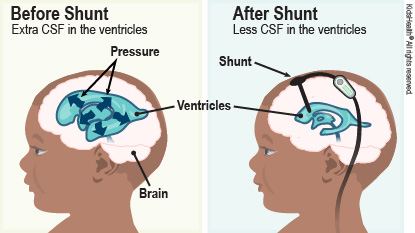Ventriculoperitoneal (VP) shunts are small plastic tubes. They help treat hydrocephalus, a buildup of cerebrospinal fluid (CSF) inside the brain's ventricles. Surgeons use them to drain the extra CSF to an area deep inside the belly called the peritoneum.


Follow your surgeon's instructions for:


Your child:

How do VP shunts work? Most VP shunts are thin plastic tubes connected with a valve. One end of the tube is in a ventricle of the brain. The other end passes out of the ventricle and goes under the skin down into the peritoneum. The valve opens when the pressure in the brain gets too high. This lets CSF drain from the brain into the peritoneum. From there, it's absorbed into the bloodstream and filtered out in the kidneys. Then the body can pee out the extra fluid.
What can go wrong with a VP shunt? A shunt can get blocked or infected, or it can stop working. So it's important to follow your surgeon's instructions for when to call and when to go to the ER.